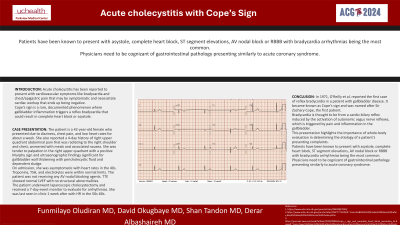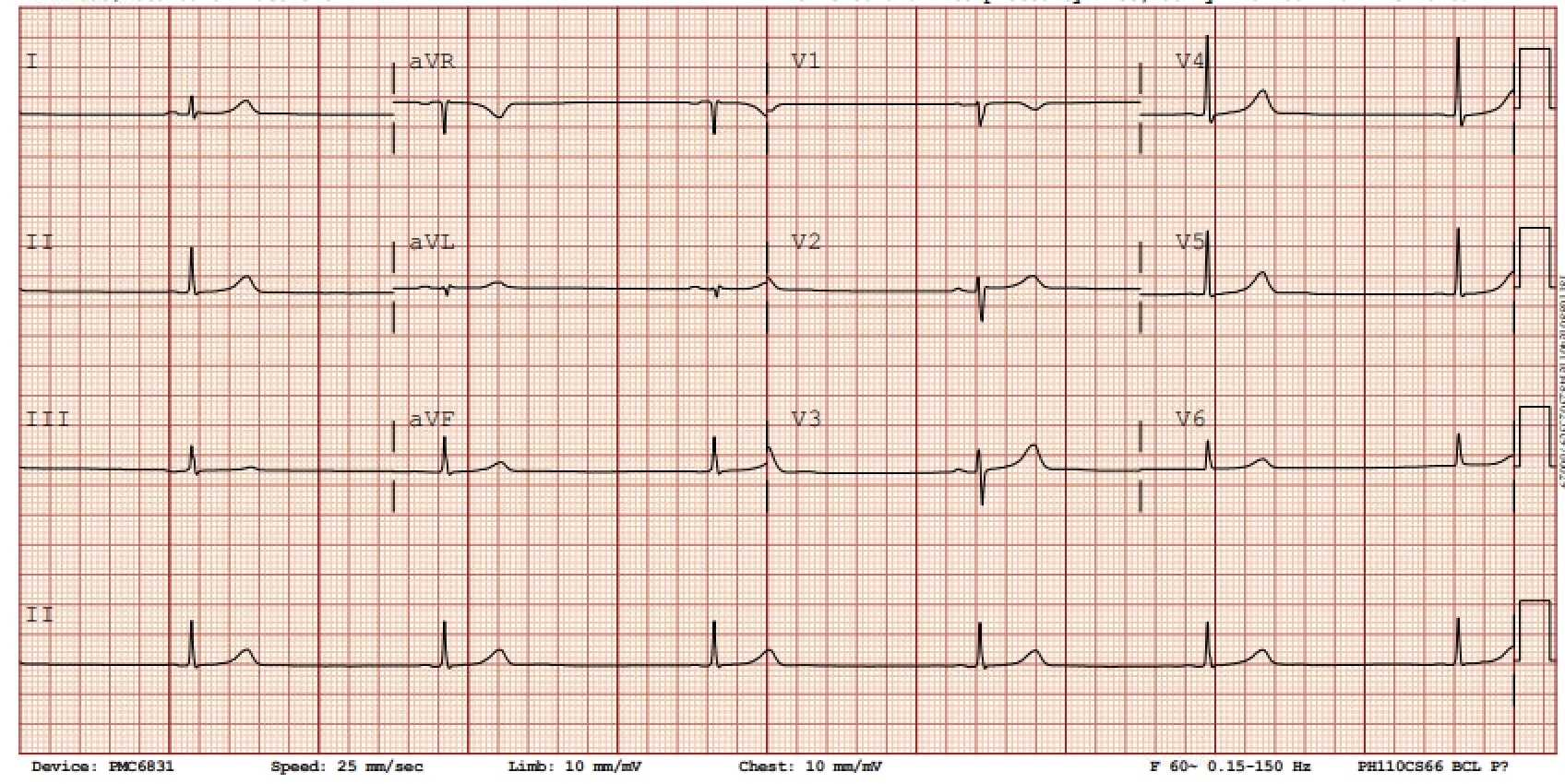Tuesday Poster Session
Category: Biliary/Pancreas
P3527 - Acute Cholecystitis With Cope's Sign
Tuesday, October 29, 2024
10:30 AM - 4:00 PM ET
Location: Exhibit Hall E

Has Audio
- FO
Funmilayo Oludiran, MD
UChealth-Parkview Medical Center
PUEBLO, CO
Presenting Author(s)
Funmilayo Oludiran, MD1, David Okugbaye, MD1, Shan Tandon, MD2, Austin Brokamp, DO1, Derar Albashaireh, MD1, Kourtney Aylor-Lee, DO3
1UChealth-Parkview Medical Center, Pueblo, CO; 2UCHealth Parkview Medical Center, Pueblo, CO; 3UChealth Parkview Medical Center, Pueblo, CO
Introduction: Acute cholecystitis has been reported to present with cardiovascular symptoms like bradycardia and chest/epigastric pain that may be symptomatic and necessitate cardiac workup that ends up being negative.
Cope’s sign is a rare, documented phenomenon where gallbladder inflammation triggers a reflex bradycardia that could result in complete heart block or asystole.
Case Description/Methods: The patient is a 42-year-old female who presented due to dizziness, chest pain, and low heart rates for about a week. She also reported a 4-day history of right upper quadrant abdominal pain that was radiating to the right shoulder and chest, worsened with meals and associated nausea. She was tender to palpation in the right upper quadrant with a positive Murphy sign and ultrasonographic findings significant for gallbladder wall thickening with pericholecystic fluid and dependent sludge
On admission, she was asymptomatic with heart rates in the 40s. Troponins, TSH, and electrolytes were within normal limits. The patient was not receiving any AV nodal blocking agents. TTE showed normal LVEF with no structural abnormalities.
The patient underwent laparoscopic cholecystectomy and received a 7-day event monitor to evaluate for arrhythmias. She was last seen in clinic 1 week after with HR in the 50s-60s.
Discussion: In 1971, O'Reilly et al. reported the first case of reflex bradycardia in a patient with gallbladder disease. It became known as Cope's sign and was named after Sir Zachary Cope, the first patient.
Bradycardia is thought to be from a cardiopulmonary reflex induced by the activation of autonomic vagus nerve reflexes, which is triggered by pain and inflammation in the gallbladder.
This presentation highlights the importance of whole-body evaluation in determining the etiology of a patient's presenting complaints.
Patients have been known to present with asystole, complete heart block, ST segment elevations, AV nodal block or RBBB with bradycardia arrhythmias being the most common.
Physicians need to be cognizant of gastrointestinal pathology presenting similarly to acute coronary syndrome.

Disclosures:
Funmilayo Oludiran, MD1, David Okugbaye, MD1, Shan Tandon, MD2, Austin Brokamp, DO1, Derar Albashaireh, MD1, Kourtney Aylor-Lee, DO3. P3527 - Acute Cholecystitis With Cope's Sign, ACG 2024 Annual Scientific Meeting Abstracts. Philadelphia, PA: American College of Gastroenterology.
1UChealth-Parkview Medical Center, Pueblo, CO; 2UCHealth Parkview Medical Center, Pueblo, CO; 3UChealth Parkview Medical Center, Pueblo, CO
Introduction: Acute cholecystitis has been reported to present with cardiovascular symptoms like bradycardia and chest/epigastric pain that may be symptomatic and necessitate cardiac workup that ends up being negative.
Cope’s sign is a rare, documented phenomenon where gallbladder inflammation triggers a reflex bradycardia that could result in complete heart block or asystole.
Case Description/Methods: The patient is a 42-year-old female who presented due to dizziness, chest pain, and low heart rates for about a week. She also reported a 4-day history of right upper quadrant abdominal pain that was radiating to the right shoulder and chest, worsened with meals and associated nausea. She was tender to palpation in the right upper quadrant with a positive Murphy sign and ultrasonographic findings significant for gallbladder wall thickening with pericholecystic fluid and dependent sludge
On admission, she was asymptomatic with heart rates in the 40s. Troponins, TSH, and electrolytes were within normal limits. The patient was not receiving any AV nodal blocking agents. TTE showed normal LVEF with no structural abnormalities.
The patient underwent laparoscopic cholecystectomy and received a 7-day event monitor to evaluate for arrhythmias. She was last seen in clinic 1 week after with HR in the 50s-60s.
Discussion: In 1971, O'Reilly et al. reported the first case of reflex bradycardia in a patient with gallbladder disease. It became known as Cope's sign and was named after Sir Zachary Cope, the first patient.
Bradycardia is thought to be from a cardiopulmonary reflex induced by the activation of autonomic vagus nerve reflexes, which is triggered by pain and inflammation in the gallbladder.
This presentation highlights the importance of whole-body evaluation in determining the etiology of a patient's presenting complaints.
Patients have been known to present with asystole, complete heart block, ST segment elevations, AV nodal block or RBBB with bradycardia arrhythmias being the most common.
Physicians need to be cognizant of gastrointestinal pathology presenting similarly to acute coronary syndrome.

Figure: Sinus bradycardia HR 35bpm
Disclosures:
Funmilayo Oludiran indicated no relevant financial relationships.
David Okugbaye indicated no relevant financial relationships.
Shan Tandon indicated no relevant financial relationships.
Austin Brokamp indicated no relevant financial relationships.
Derar Albashaireh indicated no relevant financial relationships.
Kourtney Aylor-Lee indicated no relevant financial relationships.
Funmilayo Oludiran, MD1, David Okugbaye, MD1, Shan Tandon, MD2, Austin Brokamp, DO1, Derar Albashaireh, MD1, Kourtney Aylor-Lee, DO3. P3527 - Acute Cholecystitis With Cope's Sign, ACG 2024 Annual Scientific Meeting Abstracts. Philadelphia, PA: American College of Gastroenterology.
